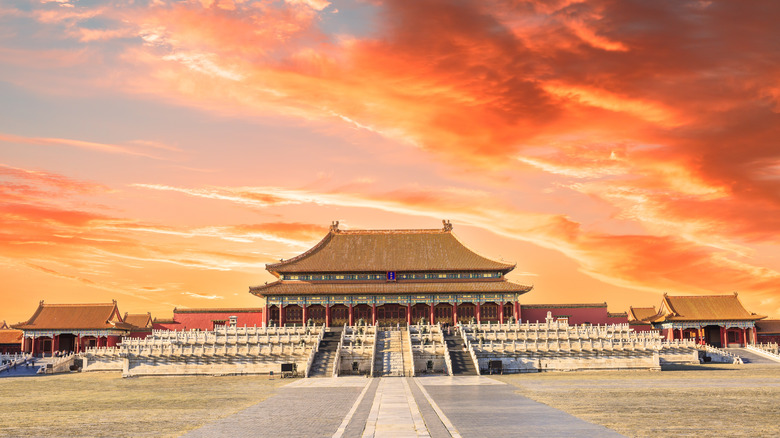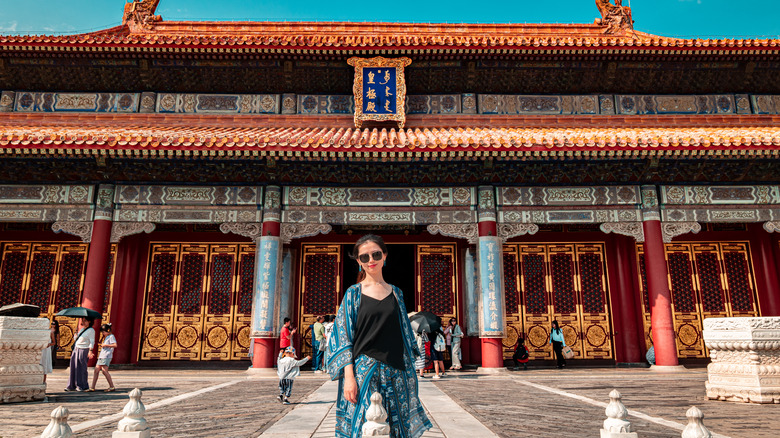This Top Tourist Destination In China Is A Must-Visit For History-Buffs
Every year, 16 million people from around the globe flock to one of Unesco's World Heritage Sites located in the heart of Beijing, China. In all likelihood, you've already heard of it: It's called the Forbidden City. Built in 1420, the Forbidden City (so named because most subjects weren't allowed to enter its walls) housed the palace of the Ming Dynasty and its emperor Yongle. It contains more than 900 buildings and spans more than 7.75 million square feet. If you compare that with other royal estates, National Geographic points out that it's 50x as big as Buckingham Palace. Yowzer.
Two dynasties of imperial rule flourished here until 1911, and it lies on the remains of a previous palace structure from the 12th century, meaning that the Forbidden City is definitely a must-visit for those jonesing for a trip rich in history. However, the Forbidden City has also been the site of a lot of recent historical events that rocked the world. That includes one of the most headline-grabbing pro-democracy protests of the 20th century that was brutally squashed by China. Here's everything you need to know before visiting the historical Forbidden City.
500 years of history to be discovered inside the Forbidden City
If the Forbidden City is ringing a bell for you, you may have seen the 1988 Oscar-winning movie "The Last Emperor," which depicted Qing dynasty emperor Puyi's life over the course of 60 years until he was deposed by the Republic in 1911. From 1420 until Puyi's last day as emperor, the Forbidden City served as the private sanctuary for the Chinese Ming and Qing dynastic rulers from the hustle and bustle of the city around them, with only eunuchs, servants, and concubines allowed inside the palace walls. There were also gardens, courtyards, exhibition spaces, living quarters, and more on site, which have since opened to the public, including 340,000 artifacts on view. A visit to the palace is an incredible way to absorb 500 years of history in just one visit.
One awe-inspiring way to take in the sheer majesty and magnanimity of the site is to walk the palace walls, which has been allowed since 2018. Tourists can walk about 75% of the wall which spans in total 2.1 miles. Another highly recommended activity is to view the Treasure Gallery, which has objects on display used by the dynastic rulers, from jewelry to cutlery, giving us insight into their everyday lives.
Tiananmen Square was the site of a violent crackdown in 1989
While the history of the Forbidden City is fascinating for ancient history buffs, if you're also interested in recent history (or just old enough to remember), the palace has been the site of one of the most iconic (and tragic) student protests in 20th century history. In 1989, a student-led democracy protest conglomerated in Tiananmen Square, which is right in front of the Forbidden City gates. They occupied the square for weeks in an effort to increase their democratic freedoms that other countries enjoy, until the Chinese government instituted martial law and began violently cracking down on the protestors. Reports vary in terms of number of casualties; the Chinese government says 200 died, while the British ambassador to China claims it was closer to 10,000 (via BBC).
The Tiananmen Square protests also gave us perhaps the most iconic photograph of the era, Tank Man, photographed by Jeff Widener. The image shows an unknown man standing in front of a line of artillery tanks entering the square, carrying merely two shopping bags, effectively using his body to hold off the brutal military crackdown. The photograph was nominated for the Pulitzer Prize.

